Abstract
As a global trend in mental health and welfare services, the community is increasingly considered to play a central role in the lives of people with mental illness. Group homes (GHs) are used globally as a means of promoting deinstitutionalization and establishing community life. The Japanese government issued a call to build Community-Based Integrated Care Systems for people with mental illness (CICSM). Therefore, we evaluated the location characteristics of GHs to determine the feasibility of daily life skills training, using a Geographic Information System (GIS). The target area was Ishikawa Prefecture. The size of everyday living areas (ELAs) for older adults was set at 1.8 km, and at 2.5 km for adults. We counted the number of service providers (SPs). Two GHs in the adult ELA and two GHs in the older adult ELA did not have SPs. Eight GHs had only one SP in their ELAs. Results showed that GHs with no or a few SPs in their ELAs are disadvantaged in shopping skills training. These findings may help people with mental illness in various countries develop support plans to effectively provide daily life training, considering the characteristics of the geographical environment and social resources around their living bases.
1. Introduction
In the Japanese psychiatric medical system, the Japanese Ministry of Health, Labour and Welfare (MHLW) strives to shorten the length of hospital stays by switching from hospital treatment to community mental health services, but deinstitutionalization efforts have not progressed sufficiently. The MHLW introduced the Vision for Reform of Mental Health and Medical Welfare in 2004, and set a 10-year goal of reducing the number of beds dedicated to mentally ill patients to about 70,000 []. However, this number has been reduced, to date, by only about 20,000 [,]. In 2020, there were approximately 270,000 inpatients with mental illness in Japan, and approximately 170,000 (62%) were inpatients for one year or longer []. In 2017, the MHLW indicated the need to build a Community-Based Integrated Care System for people with mental illness (CICSM) as a means by which long-term inpatients could return home and live in their communities. A new CICSM was established with reference to the community-based integrated care system that had already been implemented in Japan to cope with the rapidly aging population; it redefined the target population by replacing older adults with people with mental illness of all generations (from children to older adults).
As a global trend in mental health and welfare services, the community is increasingly considered to be the base and center of life for people with mental illness. Inpatient care is limited to the acute phase, and diverse mental health, medical, and welfare professionals are developing outreach activities in the community using a team-based approach. CICSMs in Japan can comprehensively provide medical care, disability welfare, caregiving, housing, social participation (working), community support, and education so people with mental illness can live independently in the area where they are accustomed to living []. The construction of a CICSM aims to encourage the discharge of long-term inpatients who have remained hospitalized so long because of a lack of housing and the patients’ difficulties with social participation. The readmission rate within one year owing to the exacerbation of mental illness is reported to be 22% in the United States [], 46% in Italy [], and 43% in Japan []. For people with mental illness to be discharged from the hospital and continue to live in the community, it is necessary to provide support that takes their symptoms and illness in the chronic phase into account regardless of the geographic location of the community environment. Patients with chronic schizophrenia have reduced neurocognitive function such as processing speed, sustained attention, working memory, visual learning, and problem solving [,].
Patients with impaired executive function owing to schizophrenia reportedly have difficulty performing activities of daily life []. Moreover, findings show that even though their symptoms may be in remission, people with mental illness tend to relapse because of non-adherence to treatment, substance misuse, lack of social support, and/or hostile family support []. To prevent readmission, it is necessary to provide follow-up visits from hospitals, maintenance of medication compliance, and community-based services that consider the living environment and the regional characteristics []. The support of community-based services that can provide training to help inpatients move from hospital to the community is essential globally.
Group homes (GHs) are used in mental health and welfare services internationally, as a means of promoting deinstitutionalization and establishing community life. In Japan, one of the community-based services provided by a CICSM is GHs. GHs for people with mental illness in Japan aim to promote rehabilitation, independence, and social participation by supporting their daily life and providing daily consultations []. GHs are available over the age of 18. A GH is positioned as a residence to which long-term inpatients can be discharged and where they can live in the community. The number of GHs in Japan was about 3000 in 2008, but increased about 2.8 times by 2019 [,]. The target market for GHs is assumed to be those who want to live alone; however, many long-term inpatients worry about living in the community immediately after being discharged []. The decline in the daily life skills of people with mental illness who live long-term in hospital is significant and interferes with community life. Skills training has been shown to promote successful assimilation skills and to maintain their durability through repeated practice and overlearning []. A GH is required to provide roles for people with mental illness that enable them to become accustomed to the new environment and to continuously carry out daily life skills training.
In consideration of the overall population and traffic conditions, the CICSM has prescribed every-day living areas (ELAs) in which people with mental illness can reach required services for daily life within approximately 30 min on foot []. In other words, the MHLW assumes that an ELA contains the resources for living one’s life. The type, number, distance from the GH, and location of service providers (SPs) from whom a person can obtain daily necessities are important factors that allow GH residents to continue to live in the community. In particular, the type, number, and distance from the GH of SPs are important for people with mental illness who wish to acquire daily life skills that will allow them to remain in the community after being discharged. If the SP does not exist in the ELA envisioned by the CICSM, it may not be possible to perform the daily life skill training defined and performed by the CICSM. A service area analysis using a Geographic Information System (GIS) is effective for showing the distribution of SPs in an ELA and identifying resources in the area. Studies using a service area analysis include an assessment of accessibility to health centers [], accessibility to public parks for examining their usability [,], the appropriate location of police stations [], and the appropriate location of fire stations in terms of fire-risk assessment []. Using a GIS service area analysis has enabled researchers to understand the resources centered around GHs in relation to ELAs, and to conceptualize the content and methods of effective daily life skills training.
The purpose of this study was to evaluate whether or not the location characteristics of GHs are appropriate for daily life skill training to be performed within the ELA defined by the CICSM. The results of this study may provide GHs with an effective approach to make it possible to accept difficult-to-discharge inpatients with long-term hospitalized mental illnesses such as chronic schizophrenia, considering the social resources around the living environment regardless of differences in mental health and welfare systems between nations.
2. Materials and Methods
2.1. Target Area
The target area was Ishikawa Prefecture in the Hokuriku region of Japan, which is located on the Sea of Japan (Figure 1). The population was 1,127,428 as of July 2021, 18,307 (3.6% of the national total) of which have mental illness []. Of those 18,307 people in Ishikawa Prefecture 3129 (17.1%) are inpatients and 15,178 (82.9%) are outpatients.
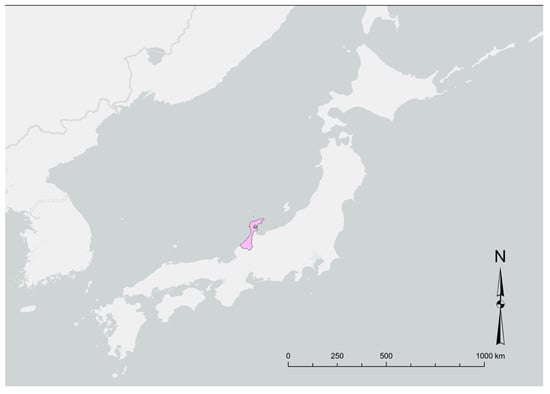
Figure 1.
Location of Ishikawa Prefecture.
2.2. Terms Used in This Study
2.2.1. Community-Based Integrated Care System for People with Mental Illness (CICSM)
It has been noted that the average length of hospital stay for people with mental illness in Japan is longer than in other countries []. The MHLW’s Vision for the Reform of Mental Health and Medical Welfare in 2004 indicated the need for switching from care “centered on inpatient medical care” to care “centered on community life” []. As of June 2018, there were 170,000 people with mental illness who had been hospitalized for more than one year. According to the Medical Institution for Hospitalization, about 40% of these patients can be discharged if home-based services are in place. In their efforts to develop home-based services to support people with mental illness in the community, the government illustrated the need to build a comprehensive community care system that also supports people with mental illness, by referencing the CBICS that is in place for older adults. More specifically, for people with mental illness to live as members of the community, the MHLW aims to build a comprehensive system that provides medical care, disability welfare, long-term care, social participation, housing, community support, and education []. CICSMs are designed to target people with mental illness of all ages.
2.2.2. Every-Day Living Area (ELA)
Every-day living areas are areas where residents live most of their daily lives, and where necessary services can be accessed within 30 min (walking), taking into consideration geographical conditions, population, and traffic conditions. In this study, we referred to the CICSM’s guidelines [] to determine a walking distance of no more than 30 min from the GH for people with mental illness.
2.3. Types and Sources of Data Used for Analysis
Table 1 shows the types and sources of data used for analysis.

Table 1.
Data sources used for analysis.
2.4. Data Collection
This study used open data to examine whether GH location characteristics using GIS are appropriate for daily life skill training performed within the ELA, as defined by the CICSM. We obtained the addresses of GHs where people with mental illness live [], and of SPs where the residents likely obtain their daily necessities (i.e., supermarkets, convenience stores, and drugstores), from information published on the Internet [,].
2.5. GH Capacity and Geographical Distribution
We targeted GH, supermarket, convenience store, and drug store addresses in 2021. We used a GIS to map the GHs, supermarkets, convenience stores, and drugstores that we identified as relevant. We calculated the total and median capacities of the GHs.
2.6. Service Area Analysis of Distance from GHs to SPs to Obtain Daily Necessities
We conducted a service area analysis using the GIS to identify the range of distances from a GH to SPs where residents go to obtain their daily necessities. The distance was covered on foot; the walking speed was set to 3.6 km/h for older adults [] and 5.0 km/h for adults. To qualify as an ELA, the distance must be what a person can reach in 30 min of walking from their GH; this was calculated as 1.8 km for older adults (ELA for older adults) and 2.5 km for adults (ELA for adults). In Figure 2, Figure 3, Figure 4, Figure 5, Figure 6, Figure 7 and Figure 8, ELAs for older adults are shown in light purple and ELAs for adults are shown in dark purple. We also counted the number of SPs in each ELA. In addition, this analysis accounted for traffic information in its description of the geographic range in which a person can move. All data used in this study were open data and did not contain any personal information.
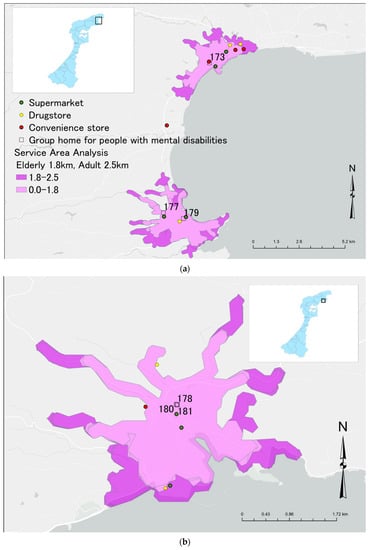
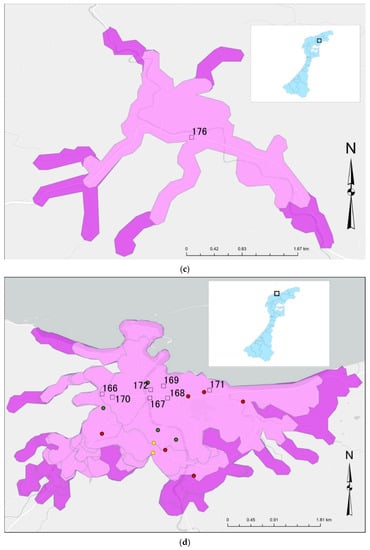
Figure 2.
(a) Geographical distribution of GHs and SPs in ELAs in Suzu City and Noto Town. (b) Geographical distribution of GHs and SPs in ELAs in Noto Town (For legends, see Figure 2a). (c) Geographical distribution of GHs and SPs in ELAs in Noto Town (For legends, see Figure 2a). (d) Geographical distribution of GHs and SPs in ELAs in Wajima City (For legends, see Figure 2a).
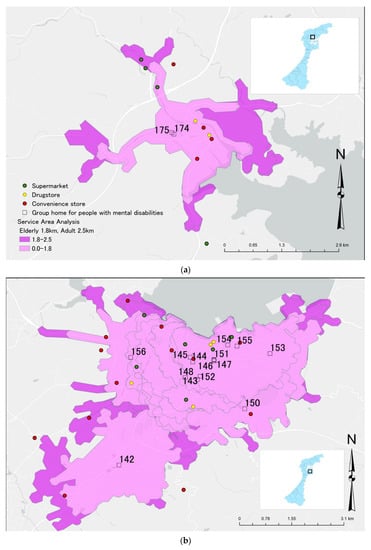
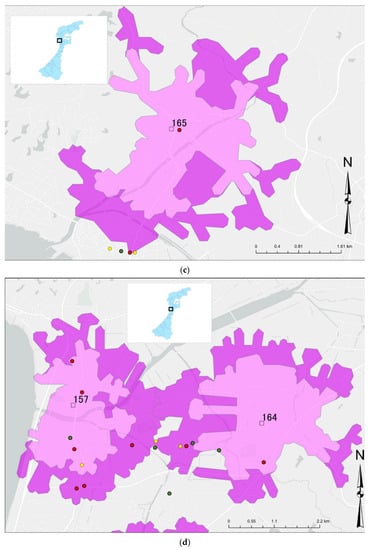
Figure 3.
(a) Geographical distribution of GHs and SPs in ELAs in Anamizu Town. (b) Geographical distribution of GHs and SPs in ELAs in Nanao City (For legends, see Figure 3a). (c) Geographical distribution of GHs and SPs in ELAs in Shika Town (For legends, see Figure 3a). (d) Geographical distribution of GHs and SPs in ELAs in Hakui City (For legends, see Figure 3a).
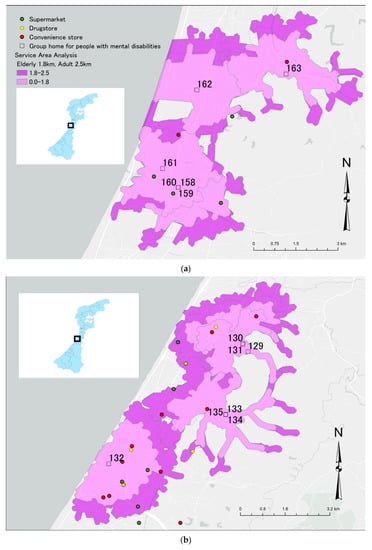
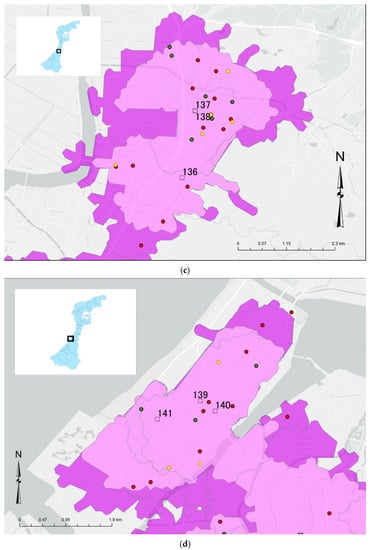
Figure 4.
(a) Geographical distribution of GHs and SPs in ELAs in Houdatshushimizu Town. (b) Geographical distribution of GHs and SPs in ELAs in Kahoku City (For legends, see Figure 4a). (c) Geographical distribution of GHs and SPs in ELAs in Tsubata Town (For legends, see Figure 4a). (d) Geographical distribution of GHs and SPs in ELAs in Uchinada Town (For legends, see Figure 4a).
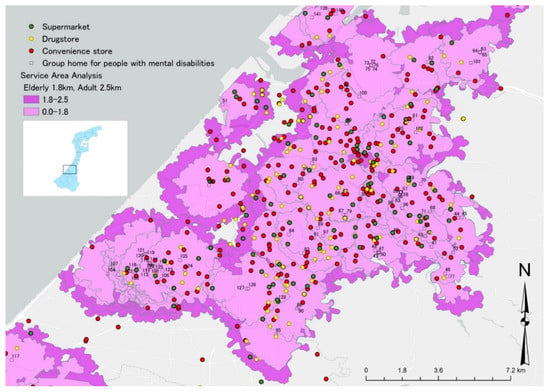
Figure 5.
Geographical distribution of GHs and SPs in ELA in Kanazawa City, Nonoichi City, and Hakusan City.
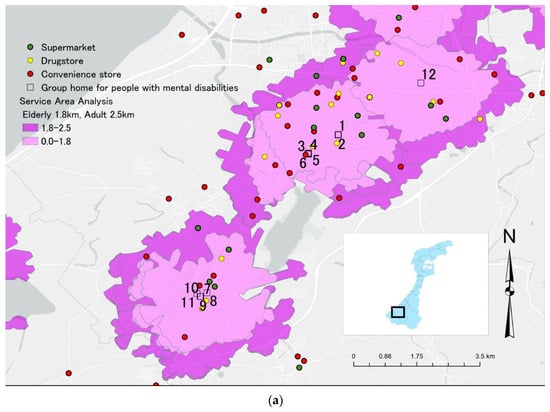
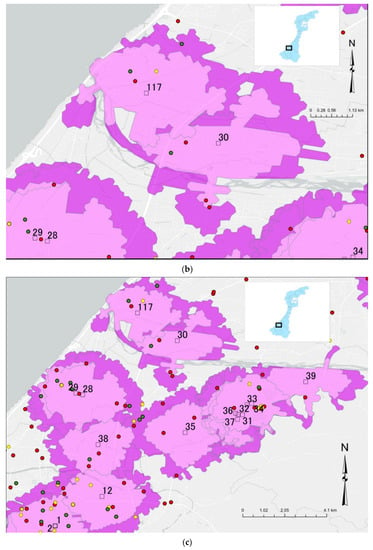
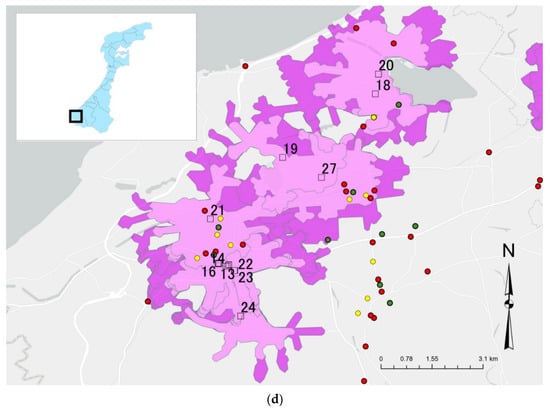
Figure 6.
(a) Geographical distribution of GHs and SPs in ELAs in Komatsu City. (b) Geographical distribution of GHs and SPs in ELAs in Kawakita Town (For legends, see Figure 6a). (c) Geographical distribution of GHs and SPs in ELAs in Nomi City (For legends, see Figure 6a). (d) Geographical distribution of GHs and SPs in ELAs in Kaga City (For legends, see Figure 6a).
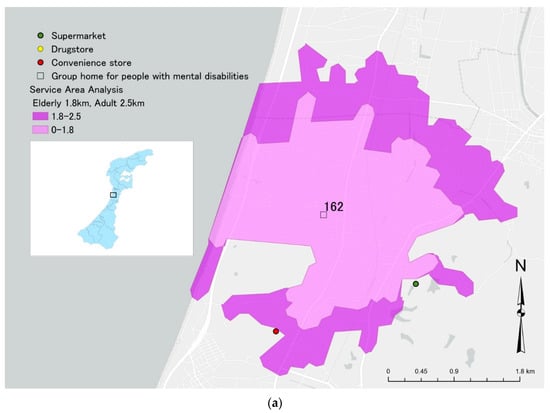
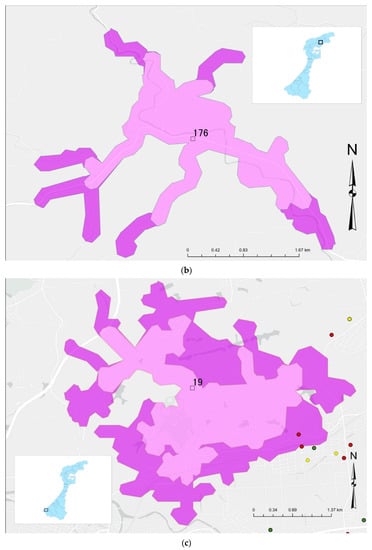
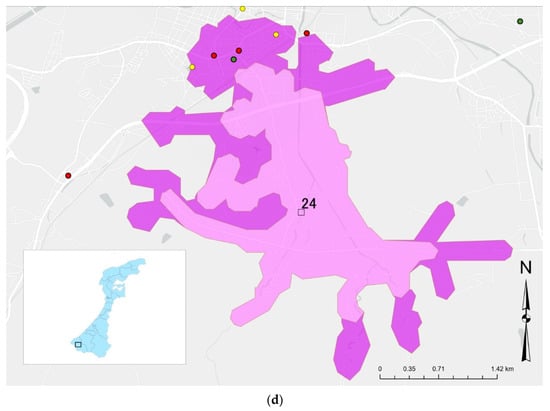
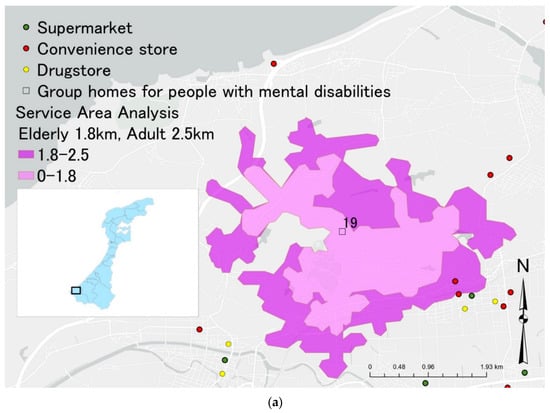
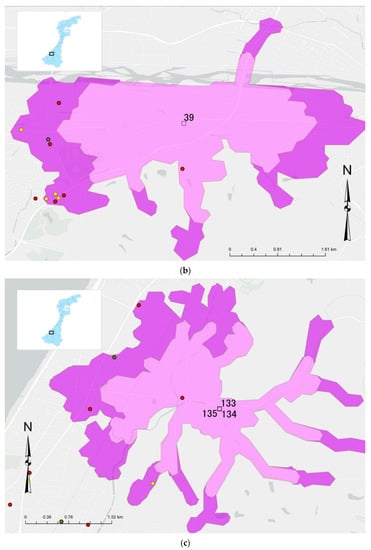
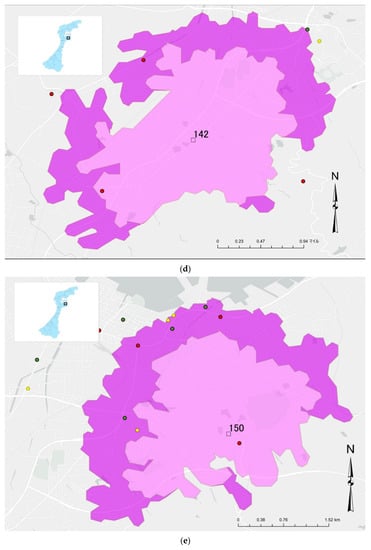
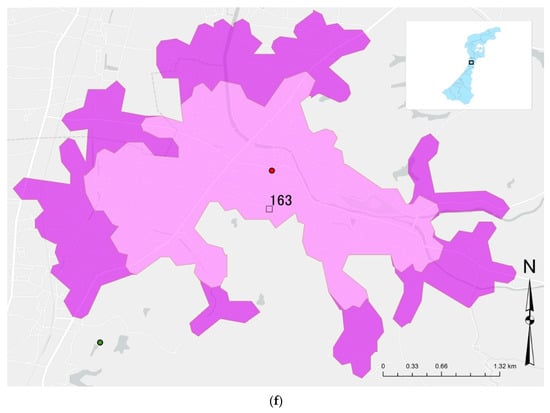
Figure 8.
(a) GH with only one SP in its ELA for adults. (b) GH with only one SP in its ELA for older adults (For legends, see Figure 8a). (c) GH with only one SP in its ELA for older adults (For legends, see Figure 8a). (d) GH with only one SP in its ELA for older adults (For legends, see Figure 8a). (e) GH with only one SP in its ELA for older adults (For legends, see Figure 8a). (f) GH with only one SP in its ELA for older adults (For legends, see Figure 8a).
3. Results
3.1. Geographical Distribution of GHs and SPs in ELAs
There were 181 GHs for people with mental illness in Ishikawa Prefecture at the time of data collection. Their combined capacity was 1153 people; the median capacity was six people (range 1–36). SPs comprised 305 supermarkets, 471 convenience stores, and 233 drugstores. In Figure 2, Figure 3, Figure 4, Figure 5, Figure 6, Figure 7 and Figure 8, the range of ELAs for older adults is shown in light purple, and the range of ELAs for adults is shown in dark purple. Distribution of GHs and SPs for people with mental illness in ELAs is shown in Figure 2, Figure 3, Figure 4, Figure 5 and Figure 6.
3.2. Location Status of GHs with No SPs in Their ELAs
Two GHs did not have any SPs in their ELAs: ID 162 in Houdatshushimizu Town, and ID 176 in Noto Town. Two other GHs did not have any SPs in their ELAs for older adults: ID 19 and 24, both in Kaga City.
3.3. Location Status of GH with Only One SP
The GH with only one SP in its ELA for adults was ID 19, in Kaga City. Seven GHs had only one SP in their ELAs for older adults: ID 39 in Nomi City; ID 133, 134, and 135 in Kahoku City; ID 142 and 150 in Nanao City; and ID 163 in Houdatshushimizu Town.
4. Discussion
According to the GIS-based service area analysis, residents in areas that do not have SPs in their ELAs (i.e., ID 162 in Houdatshushimizu Town and ID 176 in Noto Town) cannot obtain daily necessities. These situations are inconsistent with the CICSM’s definition of an ELA: an area where the services necessary for daily life are generally provided. However, it is difficult for GH residents of the identified areas to shop locally. Therefore, GH residents in areas ID 163 and 149 cannot receive daily life skills training for living alone after leaving their GH. It has been pointed out that shopping accuracy for people with schizophrenia is related to processing speed and sustained attention []. Furthermore, redundancy while shopping is related to good planning and organizational skills, and to the understanding of categories or abstract concepts []. Shopping in a real-life environment reportedly improves executive function and Instrumental Activities of Daily Life in people with schizophrenia []. Therefore, it is important for GH residents with mental difficulties to perform their daily life skills training under natural circumstances before they start living in the area. Food procurement and shopping training in ID 162 in Houdatshushimizu Town and ID 176 in Noto Town should thus be planned with the assumption that necessary resources do not exist in those ELAs. It is important, moreover, to assess in advance the distribution and geographical characteristics of available resources in the ELAs using a GIS.
As defined by a CICSM, an ELA for older adults has a radius of no more than 1.8 km, which is narrower than ELAs for adults. Thus, residents of ID 19 and 24 in Kaga City may not be able to obtain food and other daily necessities. It has been pointed out that older adults living alone in Japan face the risk that shopping may become too difficult because the supermarket is more than 1 km away, their car use is infrequent, and they find it difficult to walk []. Even considering the above, the distance from the GH to the SPs and the existence of the SPs are important factors for performing daily life skills training in the GH.
As mentioned previously, seven ELAs for older adults in this study had only one SP (i.e., ID 39 in Nomi City, ID 133, 134 and 135 in Kahoku City, ID 142 and 150 in Nanao City, and ID 163 in Houdatshushimizu Town). It has been reported that people with delusions employ the most coping behaviors to avoid threatening situations []. Furthermore, the use of community care by older people with delusional symptoms can be negatively affected by their cognitive dysfunction []. Therefore, if ELAs for older adults have only one SP, and residents are subject to delusions, healthcare staff should keep in mind that such residents may actively avoid using the SPs.
On the basis of the foregoing observations, in cases where daily necessities are not accessible to GH residents in their ELAs, we suggest that a home delivery service should be implemented, or a shuttle bus service should be used to take residents to urban areas. It has been pointed out that the ratio of using delivery services for disadvantaged shoppers is higher in areas where many low-functioning independent older people live, and in areas where many economically poor seniors and those isolated from family members dwell []. If people with mental illness have a high internet literacy, training them to use online shopping may also be useful. If there are few SPs near their own home, a two-step daily life skills training may be beneficial. That is, first, people with mental illness are trained in shopping skills and meal preparation skills at a GH in an urban area. Second, once the basic skills are acquired, the training moves to their local GH and is implemented in an environment close to home. This method may reduce the significant environmental gap caused by suddenly returning to a home with few social resources available in the ELAs.
To increase the feasibility of daily life skills training at GHs, it is necessary to formulate discharge support that considers geographical conditions at a macro level. When CICSM policy makers are establishing ELAs and promoting the return of people with mental illness to the community, we recommend that they gain an understanding of the GH location using GIS and of the surrounding environment, and then propose concrete measures. When building a new GH, moreover, we recommend taking into consideration the local geographical features and surrounding resources.
This study involved several limitations. Because the analysis used open data in a specific area of Japan, the generalizability of the results may be limited. In addition, we discussed the feasibility of daily life skill training from the positional relationship of SPs in ELA defined by the CICSM but did not consider the contents of daily life skill training. Moreover, we did not investigate all means of transportation or the full range of activities for people with mental illness living in a GH.
Future studies will need to take these factors into account and empirically examine GH residents with mental illness and obtain the cooperation of supporters in specific areas.
5. Conclusions
Our findings show that across all ELAs analyzed in this study, the location characteristics of GHs that lacked SPs for obtaining daily necessities had the following characteristics:
- GHs without SP in ELA cannot train their residents in shopping skills as defined in the CICSM;
- For older people with mental illness, distant SPs can interfere with shopping skills training;
- GHs with only one SP may not be able to provide adequate shopping skills training because residents who experience delusions about the SP may refuse to access it.
The findings of the current study may help people with chronic mental illness in various countries develop support plans to effectively provide daily life training, considering the characteristics of the geographical environment and social resources around their living bases. It is necessary to consider services such as home delivery and transportation to other GHs in which to conduct daily life skills training for residents who have access to few SPs in their ELAs for obtaining daily necessities. In addition, if the final discharge destination for people with mental illness has only a few SPs in their ELA, we recommend a two-step training process to help them return home. As the first step, they conduct daily life skills training—and acquire basic skills—at a GH that has abundant SPs in their ELA. As the second step, they conduct daily life skills training at a GH that is similar to their home environment.
By analyzing the characteristics of the living environment using evaluation tools such as GIS for assessing the feasibility of daily life skill training, it may be possible to implement an approach to support the maintenance of community life for people with chronic mental illness that can be implemented regardless of national differences.
Author Contributions
Conceptualization, Y.N.; methodology, Y.N. and H.N., software, Y.N.; validation, Y.N. and H.N.; formal analysis, Y.N. and H.N.; investigation, Y.N.; resources, Y.N.; data curation, Y.N.; writing—original draft preparation, Y.N and H.N.; writing—review and editing, Y.N.; visualization, Y.N.; supervision, Y.N.; project administration, Y.N. All authors have read and agreed to the published version of the manuscript.
Funding
This research received no external funding.
Institutional Review Board Statement
Ethical review and approval were waived for this study due to collect open data on-line. The data do not include personal data.
Informed Consent Statement
Not applicable.
Data Availability Statement
Publicly available datasets were analyzed in this study. These data can be found here: [https://www.pref.ishikawa.lg.jp/fukusi/jiritsushienfukushi/jigyousyashiteiichiran.html] (accessed on 1 December 2021).
Acknowledgments
We thank Anita Harman for editing a draft of this manuscript.
Conflicts of Interest
The authors declare no conflict of interest.
References
- Ministry of Health, Labour and Welfare. Visions in Reform of Mental Health and Medical Welfare. Available online: https://www.mhlw.go.jp/topics/2004/09/dl/tp0902-1a.pdf (accessed on 22 March 2022).
- Ministry of Health, Labour and Welfare. Overview of Medical Facility (Static/Dynamic) Surveys, and Hospital Reports in 2002. Available online: https://www.mhlw.go.jp/toukei/saikin/hw/iryosd/02/index.html (accessed on 1 December 2021).
- Ministry of Health, Labour and Welfare. Overview of Medical Facility (Static/Dynamic) Surveys, and Hospital Reports in 2014. Available online: https://www.mhlw.go.jp/toukei/saikin/hw/iryosd/14/ (accessed on 1 December 2021).
- Ministry of Health, Labour and Welfare. Materials Related to Mental Health, Medical Care and Welfare. Available online: https://www.ncnp.go.jp/nimh/seisaku/data/ (accessed on 1 December 2021).
- Ministry of Health, Labour and Welfare. Guideline of Community-Based Integrated Care System for People with Mental Illness. Available online: https://www.mhlw-houkatsucare-ikou.jp/guide/h30-cccsguideline-all.pdf (accessed on 1 December 2021).
- Prince, J.D.; Akincigil, A.; Kalay, E.; Walkup, J.T.; Hoover, D.R.; Lucas, J.; Bowblis, J.; Crystal, S. Psychiatric Rehospitalization Among Elderly Persons in the United States. Psychiatr. Serv. 2008, 59, 1038–1045. [Google Scholar] [CrossRef]
- Attili, T.; Atti, A.R.; Moretti, F.; Pedrini, E.; Forlani, M.; Bernabei, V.; Bonafede, R.; Ronchi, D.D. Leading Cause of Re-Hospitalization in an Italian Acute Psychiatric Unit: Preliminary Results. Eur. Psychiatry 2011, 26, 512. [Google Scholar] [CrossRef]
- Yamanouchi, Y. Considering Community “Recovery” from Hospital Discharge Rate and Re-Hospitalization Rate. J. Ment. Health 2018, 64, 57–61. [Google Scholar]
- Corigliano, V.; De Carolis, A.; Trovini, G.; Dehning, J.; Di Pietro, S.; Curto, M.; Donato, N.; De Pisa, E.; Girardi, P.; Comparelli, A. Neurocognition in Schizophrenia: From Prodrome to Multi-Episode Illness. Psychiatry Res. 2014, 220, 129–134. [Google Scholar] [CrossRef]
- Evans, J.D.; Heaton, R.K.; Paulsen, J.S.; Palmer, B.W.; Patterson, T.; Jeste, D.V. The Relationship of Neuropsychological Abilities to Specific Domains of Functional Capacity in Older Schizophrenia Patients. Biol. Psychiatry 2003, 53, 422–430. [Google Scholar] [CrossRef]
- Lipskaya, L.; Jarus, T.; Kotler, M. Influence of Cognition and Symptoms of Schizophrenia on IADL Performance. Scand. J. Occup. Ther. 2011, 18, 180–187. [Google Scholar] [CrossRef]
- Mgutshini, T. Risk Factors for Psychiatric Re-Hospitalization: An Exploration. Int. J. Ment. Health Nurs. 2010, 19, 257–267. [Google Scholar] [CrossRef]
- Romansky, J.B.; Lyons, J.S.; Lehner, R.K.; West, C.M. Factors Related to Psychiatric Hospital Readmission Among Children and Adolescents in State Custody. Psychiatr. Serv. 2003, 54, 356–362. [Google Scholar] [CrossRef]
- Ministry of Health, Labour and Welfare. Welfare Service for Persons with Disabilities. Available online: https://www.mhlw.go.jp/stf/seisakunitsuite/bunya/hukushi_kaigo/shougaishahukushi/service/naiyou.html (accessed on 2 December 2021).
- Ministry of Health, Labour and Welfare. Overview about Survey of Social Welfare Institutions in 2008. Available online: https://www.mhlw.go.jp/toukei/saikin/hw/fukushi/08/dl/kekka-jigyo1.pdf (accessed on 1 December 2021).
- Ministry of Health, Labour and Welfare. Overview about Survey of Social Welfare Institutions in 2019. Available online: https://www.mhlw.go.jp/toukei/saikin/hw/fukushi/19/dl/kekka-kihonhyou02.pdf (accessed on 1 December 2021).
- Ministry of Health, Labour and Welfare. Future Direction of Measures for People with Mental Illness Who Have Been Hospitalized for a Long-Term to Facilitate Transition from Institutional to Community Setting. Available online: https://www.mhlw.go.jp/file/05-shingikai-12201000-shakaiengokyokushougaihokenfukushibu-kikakuka/0000051138.pdf (accessed on 1 December 2021).
- Kopelowicz, A.; Liberman, R.P.; Zarate, R. Recent Advances in Social Skills Training for Schizophrenia. Schizophr. Bull. 2006, 32, S12–S23. [Google Scholar] [CrossRef]
- Murad, A. Using GIS for Determining Variations in Health Access in Jeddah City, Saudi Arabia. ISPRS Int. J. Geo-Inf. 2018, 7, 254. [Google Scholar] [CrossRef] [Green Version]
- Oh, K.; Jeong, S. Assessing the Spatial Distribution of Urban Parks Using GIS. Landsc. Urban. Plan. 2007, 82, 25–32. [Google Scholar] [CrossRef]
- Seifu, S.; Stellmacher, T. Accessibility of Public Recreational Parks in Addis Ababa, Ethiopia: A GIS Based Analysis at Sub-City Level. Urban. For. Urban. Green. 2021, 57, 126916. [Google Scholar] [CrossRef]
- Elsheiïkh, R. GIS-Based Services Analysis and Multi-Criteria for Optimal Planning of Location of a Police Station. Gazi Univ. J. Sci. 2022, 35, 1. [Google Scholar] [CrossRef]
- Dong, X.; Li, Y.; Pan, Y.; Huang, Y.; Cheng, X. Study on Urban Fire Station Planning Based on Fire Risk Assessment and GIS Technology. Procedia Eng. 2018, 211, 124–130. [Google Scholar] [CrossRef]
- Ishikawa Prefectual Government. Ishikawa Plan for People with Disabilities in 2019. Available online: https://www.pref.ishikawa.lg.jp/fukusi/oshirase/documents/plan2019_book.pdf (accessed on 1 December 2021).
- Okayama, T.; Usuda, K.; Okazaki, E.; Yamanouchi, Y. Number of Long-Term Inpatients in Japanese Psychiatric Care Beds: Trend Analysis from the Patient Survey and the 630 Survey. BMC Psychiatry 2020, 20, 522. [Google Scholar] [CrossRef]
- NAVITIME. Supermarkets Lists in Ishikawa Prefecture. Available online: https://www.navitime.co.jp/category/0202/17/ (accessed on 3 December 2021).
- Google Maps. Available online: https://www.google.co.jp/maps/@36.6084096,136.6523904,14z (accessed on 3 December 2021).
- NAVITIME. Convenience Stores Lists in Ishikawa Prefecture. Available online: https://www.navitime.co.jp/category/0201/17/ (accessed on 22 March 2022).
- NAVITIME. Drugstores Lists in Ishikawa Prefecture. Available online: https://www.navitime.co.jp/category/0206005/17/ (accessed on 22 March 2022).
- Ishikawa Prefectual Government. Information about Social Resources. Available online: http://www.pref.ishikawa.lg.jp/fukusi/kokoro-home/kokoro/shiryou.html (accessed on 3 December 2021).
- Shimada, H.; Makizako, H.; Doi, T.; Tsutsumimoto, K.; Suzuki, T. Incidence of Disability in Frail Older Persons With or Without Slow Walking Speed. J. Am. Med. Dir. Assoc. 2015, 16, 690–696. [Google Scholar] [CrossRef]
- Rempfer, M.V.; Hamera, E.K.; Brown, C.E.; Cromwell, R.L. The Relations between Cognition and the Independent Living Skill of Shopping in People with Schizophrenia. Psychiatry Res. 2003, 117, 103–112. [Google Scholar] [CrossRef]
- Kim, Y.; Park, J.-H.; Lee, S.-A. Is a Program to Improve Grocery-Shopping Skills Clinically Effective in Improving Executive Function and Instrumental Activities of Daily Living of Patients with Schizophrenia? Asian J. Psychiatry 2020, 48, 101896. [Google Scholar] [CrossRef]
- Ishikawa, M.; Yokoyama, T.; Nakaya, T.; Fukuda, Y.; Takemi, Y.; Kusama, K.; Yoshiike, N.; Nozue, M.; Yoshiba, K.; Murayama, N. Food Accessibility and Perceptions of Shopping Difficulty among Elderly People Living Alone in Japan. J. Nutr. Health Aging 2016, 20, 904–911. [Google Scholar] [CrossRef]
- Freeman, D.; Garety, P.A.; Kuipers, E.; Fowler, D.; Bebbington, P.E.; Dunn, G. Acting on Persecutory Delusions: The Importance of Safety Seeking. Behav. Res. Ther. 2007, 45, 89–99. [Google Scholar] [CrossRef]
- Forsell, Y.; Henderson, A.S. Epidemiology of Paranoid Symptoms in an Elderly Population. Br. J. Psychiatry 1998, 172, 429–432. [Google Scholar] [CrossRef]
- Iwama, N.; Tanaka, K.; Komaki, N.; Ikeda, M.; Asakawa, T. Mapping Residential Areas of Elderly People at High Risk of Undernutrition: Analysis of Mobile Sales Wagons from the Viewpoint of Food Desert Issues. J. Geogr. Chigaku Zassi 2016, 125, 583–606. [Google Scholar] [CrossRef] [Green Version]
Publisher’s Note: MDPI stays neutral with regard to jurisdictional claims in published maps and institutional affiliations. |
© 2022 by the authors. Licensee MDPI, Basel, Switzerland. This article is an open access article distributed under the terms and conditions of the Creative Commons Attribution (CC BY) license (https://creativecommons.org/licenses/by/4.0/).